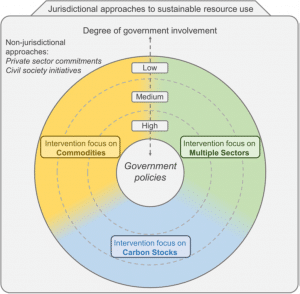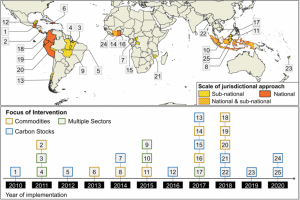Jurisdictional approaches are relatively novel and receive growing attention from a range of stakeholders. Whether they can be the missing piece in the sustainable resource use puzzle will depend to a large extent on the ability and willingness of decision makers to overcome the inadequacies of previous interventions.
Over the past 10 years, jurisdictional approaches emerged as a tool to address environmental degradation and since have received considerable attention from public, private, and civil decisionmakers. Despite their growing popularity, jurisdictional approaches have not been substantially covered in the scientific literature. In our latest study, we address this gap and take a closer look at the origins and characteristics of jurisdictional approaches, proposing a definition and typology. Our research was motivated by questions like: what attributes are common to all initiatives? How do jurisdictional initiatives differ from one another? And how do they differ from more traditional approaches to environmentally sustainable resource use?
To address these questions, we chose a qualitative and inductive approach, starting by compiling a database of 80 multi-stakeholder sustainability initiatives in the tropics to identify their defining characteristics. Consulting grey and peer-reviewed literature, we derived a set of characteristics and criteria that we use to compare the initiatives in our database. We found that jurisdictional approaches promote sustainability at the scale of jurisdictions, operate as a formalized collaboration between governments and other stakeholders, and affect policies and practices affecting all relevant stakeholders. The jurisdictional scale can be either national or subnational, as long as the participating government has authority and autonomy to implement and enforce resource use policies. For example, in many political systems, villages and municipalities lack sufficient autonomy and capacity to design and implement such policies, hence would not be considered jurisdictional. We applied this definition to our initial database and found 25 initiatives across all tropical regions that fit our definition, both at the national and sub-national scale.
In a second step, we developed a typology for categorizing jurisdictional initiatives (see Figure 1 below), using the two variables that would best capture the relevant variation among the initiatives: the degree of government involvement and the focus of the intervention. Governments play a central role in achieving sustainable resource use (see here) and we ranked government involvement as low, medium, or high depending on the government’s involvement in agenda setting, policy design, funding, and operation of the initiative. The second variable – focus of intervention – captures the origins of jurisdictional approaches and the nature of their interventions. For example, some initiatives were designed around the sustainable production of commodities, such as palm oil, cocoa, or coffee, and often have a strong private sector involvement. Others focus on carbon stocks and aim at reducing greenhouse gas emissions and slowing deforestation (see our Open Access publication for a full discussion of the categories).
Figure 1: A typology for classifying jurisdictional approaches

We also found that a large area of tropical forest is covered by jurisdictional initiatives. The 25 initiatives that fit our definition cover almost 840 million hectares, roughly 40% of the global tropical tree cover. Looking at the tree cover loss rates in these 25 initiatives, we can see that the average is higher than the global rate of tropical tree cover loss, suggesting that jurisdictional initiatives are in areas of high deforestation. This is an indication that jurisdictional approaches could slow tropical deforestation because they could provide additionality, meaning environmentally sustainable outcomes beyond what is expected from business-as-usual practices. Additionality is more easily achieved in areas with high deforestation because in those areas business-as-usual would result in rapid loss of forest cover. For example, a hypothetical jurisdictional approach in a landscape with no deforestation would provide no additionality because the forest cover in that area would not be projected to shrink under a business-as-usual scenario anyways. In practice, however, jurisdictional approaches will always provide some degree of additionality, especially when considering that deforestation rates can change rapidly and jurisdictions that are not being deforested as of today, might be deforestation hotspots in a few years from now. It is promising to see jurisdictional approaches implemented in deforestation hotspots where they can hopefully have substantial positive impact.
Figure 2: Location and timeline of 25 jurisdictional initiatives for improving sustainable resource use

Figure notes: (1) Emissions reduction through the strengthening of forest governance in vulnerable communities (Guatemala); (2) National Initiative for Sustainable Pineapple Production (INSP; Costa Rica); (3) Green Municipalities Program (Pará, Brazil); (4) Municipal Pact for the End of Illegal Deforestation (São Félix do Xingu, Brazil); (5) State System of Incentives for Environmental Services (SISA; Acre, Brazil); (6) Sustainable cocoa production in the Dominican Republic; (7) Emission Reductions Program (Sangha-Likouala, Republic of the Congo); (8) Indonesian Sustainable Palm Oil Forum (FoKSBI; Indonesia); (9) Produce, Conserve, and Include (PCI; Mato Grosso, Brazil); (10) Eco-Region Alliance (South Sumatra, Indonesia); (11) Sabah 100% Roundtable Sustainable Palm Oil (RSPO) by 2025 (Sabah, Malaysia); (12) Yucatán Peninsula Sustainability Agreement (ASPY 2030; Mexico); (13) REDD+ Emissions Reductions Program Temperate Forest Jurisdictions (Chile); (14) Cocoa and Forest Initiative (Côte d’Ivoire); (15) Emission Reductions Program (Maï-Ndombe, Democratic Republic of the Congo); (16) Cocoa and Forest Initiative (Ghana); (17) Initiative for Sustainable Landscape Approach (ISLA; Lâm Đồng and Đắk Lắk, Vietnam); (18) Cocoa, Forests and Peace Initiative (Colombia); (19) Interinstitutional Committee for Sustainable Palm Oil (CISPS; Ecuador); (20) National Coffee Action Plan (Peru); (21) Integrated Landscape Management Program (Zambézia, Mozambique); (22) Nan Sandbox (Thailand); (23) Reducing Emissions and Enhancing Livelihoods (Fiji); (24) Emissions Reduction Program (Taï National Park, Côte d’Ivoire); (25) Jurisdictional Emission Reductions Program (East Kalimantan, Indonesia). Map made with Natural Earth.
Jurisdictional approaches have the potential to overcome several of their precursors’ limitations. For example, they are typically comprised of multiple stakeholders which can prevent marginalization of certain groups and reconcile diverging interests of private, public, and civil society actors. And since jurisdictional approaches operate at policy-relevant boundaries, governments have better authority over monitoring and enforcement. Another opportunity is that policies and practices can be applied to all relevant actors in a jurisdiction. This avoids that only those actors that can easily comply with regulations due to their favorable location or pre-existing sustainable practices engage in sustainable resource use.
To realize these opportunities, however, jurisdictional approaches will need to overcome several challenges. For example, jurisdictional initiatives require substantial financial resources, and attracting and sustaining sufficient funding can be a major obstacle. A further challenge is to maintain political support after government and bureaucratic turnovers, as seen following the election of Brazilian President Jair Bolsonaro. Another obstacle to overcome is ensuring the equity, inclusiveness, participation, and fair representation of small producers and failure to deliver on this will have significant consequences for the success of any initiative. Similarly, jurisdictional initiatives carry the risk of imposing external or local-elite values and management systems on local stakeholders. See our paper for a more detailed discussion of the challenges and opportunities of jurisdictional approaches.
An array of private sustainability commitments, public pledges, and multilateral declarations has come into effect over the past decade, and jurisdictional approaches can play important roles in delivering on their ambitious objectives. Conceptually, jurisdictional approaches have the potential to overcome the deficiencies of previous approaches and the momentum surrounding their implementation and funding can help to realize this potential. However, the challenges are substantial as well. Whether jurisdictional approaches can be the missing piece in the sustainable resource use puzzle will depend to a large extent on the ability and willingness of decision makers to acknowledge and address the inadequacies of previous interventions.
